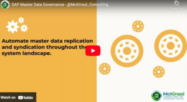SAP Master Data Governance
Filter By
Browse By
- SAP Analytics and AI
- SAP Application Development and Integration
- All SAP Application Development and Integration
- SAP ABAP
- SAP ABAP Development Tools
- SAP ABAP Test Cockpit
- SAP API Management
- SAP BAPI
- SAP Basis
- SAP BRF
- SAP Business Application Studio
- SAP CMS
- SAP Design Studio
- SAP Development Tools
- SAP DevOps
- SAP EAI
- SAP EDI
- SAP Extension Suite
- SAP Fiori
- SAP Fiori Elements
- SAP Integration Suite
- SAP Low Code Application Development
- SAP Low Code Automation
- SAP Netweaver
- SAP Release Management
- SAP UI5
- SAP Web Application Server
- SAP Web IDE
- SAP Business Process Management
- SAP Center of Excellence
- SAP CIO
- SAP Customer Experience
- SAP Data and Data Management
- All SAP Data and Data Management
- SAP BW
- SAP BW/4HANA
- SAP Crystal Reports
- SAP Data Archiving
- SAP Data Center
- SAP Data Governance
- SAP Data Integration
- SAP Data Migration
- SAP Data Quality
- SAP Data Services
- SAP Data Strategy
- SAP Data Visualization
- SAP Data Warehouse Cloud
- SAP DMS
- SAP Document Control
- SAP EIM
- SAP ETL
- SAP ETL Tools
- SAP HANA
- SAP HANA Administration
- SAP HANA Deployment Infrastructure
- SAP HANA Studio
- SAP Master Data
- SAP Master Data Governance
- SAP MDM
- SAP Enterprise Architect
- SAP Enterprise Asset Management
- SAP ERP
- SAP Finance
- All SAP Finance
- SAP Accounting
- SAP AR AP
- SAP Asset Accounting
- SAP Billing Systems
- SAP BPC
- SAP BRIM
- SAP Cash Management
- SAP Central Finance
- SAP Controlling
- SAP COPA
- SAP Cost Center Accounting
- SAP Currency Risk
- SAP e-invoicing
- SAP FICO
- SAP Finance Automation
- SAP Advanced Financial Closing
- SAP Financial Consolidation
- SAP Financial Planning
- SAP FX Risk
- SAP General Ledger
- SAP Global Tax Management
- SAP Hyperion
- SAP Order to Cash
- SAP Payment Processing
- SAP Profitability Analysis
- SAP Rebate Management
- SAP S/4HANA Finance
- SAP SWIFT Compliance
- SAP Treasury Management
- SAP Universal Journal
- SAP Governance Risk and Compliance
- SAP Human Capital Management
- SAP Intelligent Technologies
- SAP Platform and Technology
- All SAP Platform and Technology
- SAP Business Technology Platform
- SAP Cloud
- SAP Cloud Connector
- SAP Cloud Integration Platform
- SAP Cloud Migration
- SAP Cloud Platform
- SAP Cloud Providers
- SAP Cloud Strategy
- SAP Digital Signature
- SAP Container Platform
- SAP HANA Enterprise Cloud
- SAP Digital Asset Management
- SAP Smart Forms
- SAP HEC
- SAP Digital Integration Hub
- SAP Hyperscalers
- SAP Infrastructure
- SAP Messaging
- SAP Quality and Testing
- SAP Security
- SAP Spend Management
- SAP Supply Chain Management
- All SAP Supply Chain Management
- SAP APO
- SAP Asset Management
- SAP Business Network
- SAP Digital Manufacturing Cloud
- SAP Digital Twin
- SAP EWM
- SAP IBP
- SAP Inventory Management
- SAP Label Printing
- SAP Logistics
- SAP Manufacturing
- SAP Manufacturing Automation
- SAP MES
- SAP MII
- SAP MM
- SAP MRO
- SAP MRP
- SAP Order Management
- SAP Plant Maintenance
- SAP PLM
- SAP Production Planning
- SAP S&OP
- SAP SD
- SAP SPM
- SAP Supply Chain Planning
- SAP Track and Trace
- SAP Transportation Management
- SAP System Administration
Master Data Governance: An Overview and Key Considerations
What Is Master Data?
The Data Governance Institute (DGI) defines master data as “the ‘nouns’ upon which business transactions take action.”
Master data, explains DGI, “describes core entities of an enterprise that are used by multiple business process and IT systems. Examples are parties (e.g., customers, employees, vendors, and suppliers), places (e.g., locations, sales territories, and offices), and things (e.g., accounts, products, assets, and document sets).”
Master data, also known as data domains, is often thought of as the core building blocks upon which your business is built.
What Is Master Data Governance?
Master data governance can help a business achieve high-quality master data and visibility into its processes.
Master data governance can, for example, allow for a standard and consistent definition to be created to define “customer,” resulting in a single customer view across multiple lines of business. It does this by allowing a glossary of agreed terminology to be created, along with specific metadata attributes.
Master data management (MDM) can be used as a tool to support master data governance strategy; however, MDM and master data governance should not be confused as the same thing.
The master data governance solution provided by SAP, SAP Master Data Governance, allows organizations to pull together master data from all parts of the organization and manage it centrally. The SAP Master Data Governance application can be implemented on SAP S/4HANA and can be deployed on-premise or in the private or public cloud.
Key Considerations for SAPinsiders
Master Data Governance: An Overview and Key Considerations
What Is Master Data?
The Data Governance Institute (DGI) defines master data as “the ‘nouns’ upon which business transactions take action.”
Master data, explains DGI, “describes core entities of an enterprise that are used by multiple business process and IT systems. Examples are parties (e.g., customers, employees, vendors, and suppliers), places (e.g., locations, sales territories, and offices), and things (e.g., accounts, products, assets, and document sets).”
Master data, also known as data domains, is often thought of as the core building blocks upon which your business is built.
What Is Master Data Governance?
Master data governance can help a business achieve high-quality master data and visibility into its processes.
Master data governance can, for example, allow for a standard and consistent definition to be created to define “customer,” resulting in a single customer view across multiple lines of business. It does this by allowing a glossary of agreed terminology to be created, along with specific metadata attributes.
Master data management (MDM) can be used as a tool to support master data governance strategy; however, MDM and master data governance should not be confused as the same thing.
The master data governance solution provided by SAP, SAP Master Data Governance, allows organizations to pull together master data from all parts of the organization and manage it centrally. The SAP Master Data Governance application can be implemented on SAP S/4HANA and can be deployed on-premise or in the private or public cloud.
Key Considerations for SAPinsiders
The following points can help you implement effective master data governance:
- Establish master data governance business processes flows. According to the author of this technical article, “An Introduction to SAP Master Data Governance,” Mohammad Assad Shaik, says developers can use rule-based workflow (RBW) templates to configure master data governance business process flows. “RBW uses the Business Rules Framework Plus (BRF+) component as the configuration engine. Although the SAP Business Workflow is the foundation for the RBW, the look, feel, and configuration mechanism vary,” writes the author. “RBW not only supports the approval processes but also executes validations at defined steps.”
- Create a use case. In his article, Shaik describes a scenario where an enterprise is operating three SAP ECC systems, one for each business unit. The steps listed describe how the enterprise selected a deployment model for material master data maintenance using SAP Master Data Governance. Read the use case.
- Improve supply chain operations with the right master data governance tools. The data governance team at Ascend Performance Materials was tasked with improving multiple supply chain processes to help its supply chain technicians, mechanics, and other employees find the data they needed faster. To address the challenges, Ascend worked with Winshuttle (acquired by Precisely in 2021) to implement Winshuttle Foundation, a business process automation and data management platform with deep SAP integration capabilities. It also implemented Winshuttle Studio. Read how these solutions enable a flexible and iterative approach into the business.
9 results
-

SAP Master Data Governance
Reading time: 1 min
Titan Consulting’s white paper outlines strategies for businesses to achieve measurable ROI with S/4HANA by highlighting its benefits over ECC and promoting informed SAP adoption.
-

SAP Master Data Governance Enterprise Asset Management Extension by Prometheus Group
Reading time: 1 min
SAP Master Data Governance, enterprise asset management extension by Prometheus Group, is a native SAP extension designed to close that critical gap in governance, giving you the ability to realize greater uptime, increase wrench time, improve operational productivity, and reduce EH&S risks.
-

SAP Master Data Governance
Consolidate, govern, and manage the quality of master data. Automate master data replication and syndication throughout the system landscape. Use prebuilt datamodels, business rules, workflows, and user interfaces. Support all master data domains and implementation styles in a single application. Deploy on-premise or in a private or public cloud. You can get assistance with outsourcing…
-
-

Master Data Governance: An Overview
Reading time: 5 mins
In today’s data-driven world, organizations are increasingly aware of the importance of managing and controlling their data assets to drive growth, efficiency, and competitiveness. This is where Master Data Governance (MDG) comes into play. This comprehensive guide will explore the concept of MDG, its significance for businesses, and how it can be effectively implemented to…
-

Transform Your Master Data Management with GLASSWING
Reading time: 1 mins
Simplification, automation, governance – Good master data never stops. And it begins here. Discover the key benefits and the future of SAP master data management.
-

SAP Master Data Automation, Compliance, and Reporting: Putting the Process into the Hands of the Business
April 19, 2023
Upcoming Webinar | SAP Master Data Automation, Compliance, and Reporting: Putting the Process into the Hands of the Business Business teams continue to face automation and compliance challenges when managing multi-team master data creation, entry, updates, and changes. Dependance on manual processes and poorly integrated systems have left many companies struggling with inefficiency. Join experts from…
-

- SAP Master Data Governance
 Premium
Premium
Automation in Master Data Governance
Reading time: 2 mins
Automation in Master Data Governance is a critical foundation to ensure data integrity and to maintain a single source of truth for the organization. Organizational frustration can creep in with poor quality master data management, yet only 36% of respondents have MDM governance and policies in a SAPInsider research on Data Management and Data Warehousing…
-
-

Growing Need for Financial Master Data Management Automation
Reading time: 4 mins
Finance and accounting (F&A) teams must efficiently access accurate and reliable information in today’s fast-paced environment. This way, F&A teams can generate the organizational visibility to make timely decisions on various fronts, from revenue growth or cost-cutting initiatives to strategic planning for new business models or corporate transactions. Finance master data is the foundation for...…
-

- SAP Master Data Governance
 Premium
Premium
Video: Building a Robust Master Data Foundation with SimpleMDG
Master data governance is critical for success with business processes and data analytics. Yet, it is a complex challenge in today's diverse landscape. Laidon's SimpleMDG allows for a intuitive user interface to create based on pre-built templates and manage workflows with automation. Membership Required You must be a member to access this content.View Membership LevelsAlready…
Become a Member
Unlimited access to thousands of resources for SAP-specific expertise that can only be found here.
Become a Partner
Access exclusive SAP insights, expert marketing strategies, and high-value services including research reports, webinars, and buyers' guides, all designed to boost your campaign ROI by up to 50% within the SAP ecosystem.
Upcoming Events
Related Vendors
Your request has been successfully sent


